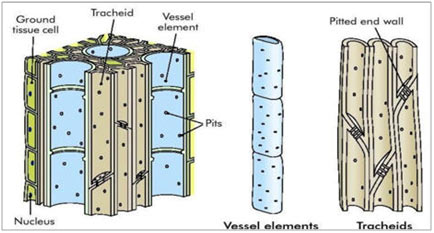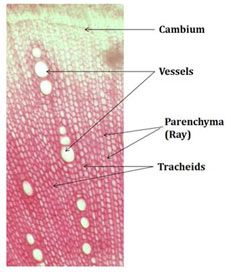Xylem
Xylems are compound non-living conducting tissues. They conduct water and dissolved salts from roots to different parts of plants. Xylem also forms wood in plants. It supports the plant body. xylem tissues are present only in tracheophytes.
Composition of Xylem
Xylem is a compound tissue. It is composed of different types of tissues. It consists of living and non-living cells. Some important tissues are vessel elements, tracheids, and vessel members.
These cells are concerned with the conduction of water and minerals. They also have supporting functions. Fibers are also present in the xylem. They are also supporting in function and strengthen the plant body.
In some cases, sclereids are also present. Parenchyma cells are involved in packing and storage. Resin ducts are present in the xylem of some plants. Xylem is composed of the following tissues and cells:
- Tracheary elements
The specialized water and salt conducting cells of the xylem are called tracheary elements. These are elongated and lignified. They have a thick secondary wall with various types of pits. These are non-living cells at maturity.
- Vessel members
The short, wide, and with perforated end walls; tracheary elements are called vessel members. These are united end to end to form long xylem vessels. The perforated endplates of vessels are called perforation plates.
The secondary walls of vessels have different thicknesses. These may be annular, spiral, scalariform, and reticulate.
- Tracheids
The tracheary elements which are elongated tube-like with tapering ends are called tracheids. They lack perforated plates. Water moves from one tracheid to adjacent through pit membranes.
These are dead empty cells with the empty lumen and no cellular contents. Their main function is the conduction of water but is also involved in supporting the plant.

- Fibers
Fibers commonly occur in xylem. These are elongated, thick-walled structures. They perform the supporting function. Mature fibers are dead cells. These are divided into the following types:
- Libriform fiber
These fibers are defined as having actually lengthened cells with the thick cell wall surface, a small number of primary pits on the wall, and really narrow cell lumen in contrast to tracheids in which they are linked in the same plant. Bordered pit hardly presents.
- Fiber-tracheid
This fiber has the characteristic that is intermediate between tracheids and libriform fibers. Unlike tracheids,fiber-tracheid is much lengthened; the cell wall surface is thicker with reduced size of surrounded pits.
- Gelatinous or mucilaginous fiber
This fiber is either libriform fiber or fiber-tracheid where the additional wall lacks lignin or is present in a small amount. The second wall has a-cellulose in its innermost layer described as G-layer. As a result, the wall comes to be extremely hygroscopic.
Parenchyma
Parenchyma is present in both primary and secondary xylems. They form vertical rows in the primary xylem. They are parallel to tracheary elements. The parenchymal cells are living cells and retain protoplast.
Softwood has a large number of parenchyma and hardwood contains fewer amounts of parenchyma. The contents of the adjacent parenchyma migrate into the tracheal elements through pits forming tylosis.
Functions of Xylem
- The principal component of vascular tissues
- Transportation of water and minerals
- Strengthen the plants
- Provides mechanical support to plants

